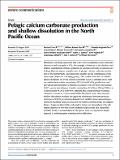Files in this item
Pelagic calcium carbonate production and shallow dissolution in the North Pacific Ocean
Item metadata
| dc.contributor.author | Ziveri, Patrizia | |
| dc.contributor.author | Gray, William Robert | |
| dc.contributor.author | Anglada-Ortiz, Griselda | |
| dc.contributor.author | Manno, Clara | |
| dc.contributor.author | Grelaud, Michael | |
| dc.contributor.author | Incarbona, Alessandro | |
| dc.contributor.author | Rae, James William Buchanan | |
| dc.contributor.author | Subhas, Adam V. | |
| dc.contributor.author | Pallacks, Sven | |
| dc.contributor.author | White, Angelicque | |
| dc.contributor.author | Adkins, Jess F. | |
| dc.contributor.author | Berelson, William | |
| dc.date.accessioned | 2023-02-21T10:30:08Z | |
| dc.date.available | 2023-02-21T10:30:08Z | |
| dc.date.issued | 2023-02-20 | |
| dc.identifier | 283457813 | |
| dc.identifier | 95d947bc-5bf8-4d5a-89f8-de4f54c6e5f6 | |
| dc.identifier | 85148678941 | |
| dc.identifier.citation | Ziveri , P , Gray , W R , Anglada-Ortiz , G , Manno , C , Grelaud , M , Incarbona , A , Rae , J W B , Subhas , A V , Pallacks , S , White , A , Adkins , J F & Berelson , W 2023 , ' Pelagic calcium carbonate production and shallow dissolution in the North Pacific Ocean ' , Nature Communications , vol. 14 , no. 1 , 805 . https://doi.org/10.1038/s41467-023-36177-w | en |
| dc.identifier.issn | 2041-1723 | |
| dc.identifier.other | Jisc: 913419 | |
| dc.identifier.other | publisher-id: s41467-023-36177-w | |
| dc.identifier.other | manuscript: 36177 | |
| dc.identifier.other | ORCID: /0000-0003-3904-2526/work/129708704 | |
| dc.identifier.uri | https://hdl.handle.net/10023/27019 | |
| dc.description | Funding: Funding was provided by NSF Grants OCE1220600 and OCE1220302 awarded to JA and WB, respectively, MINECO PID2020-113526RB-I00, the Generalitat de Catalunya MERS (#2017 SGR-1588) awarded to PZ and NERC grant NE/N011716/1 awarded to JR. | en |
| dc.description.abstract | Planktonic calcifying organisms play a key role in regulating ocean carbonate chemistry and atmospheric CO2. Surprisingly, references to the absolute and relative contribution of these organisms to calcium carbonate production are lacking. Here we report quantification of pelagic calcium carbonate production in the North Pacific, providing new insights on the contribution of the three main planktonic calcifying groups. Our results show that coccolithophores dominate the living calcium carbonate (CaCO3) standing stock, with coccolithophore calcite comprising ~90% of total CaCO3 production, and pteropods and foraminifera playing a secondary role. We show that pelagic CaCO3 production is higher than the sinking flux of CaCO3 at 150 and 200 m at ocean stations ALOHA and PAPA, implying that a large portion of pelagic calcium carbonate is remineralised within the photic zone; this extensive shallow dissolution explains the apparent discrepancy between previous estimates of CaCO3 production derived from satellite observations/biogeochemical modeling versus estimates from shallow sediment traps. We suggest future changes in the CaCO3 cycle and its impact on atmospheric CO2 will largely depend on how the poorly-understood processes that determine whether CaCO3 is remineralised in the photic zone or exported to depth respond to anthropogenic warming and acidification. | |
| dc.format.extent | 14 | |
| dc.format.extent | 2172989 | |
| dc.language.iso | eng | |
| dc.relation.ispartof | Nature Communications | en |
| dc.subject | GE Environmental Sciences | en |
| dc.subject | DAS | en |
| dc.subject | MCC | en |
| dc.subject.lcc | GE | en |
| dc.title | Pelagic calcium carbonate production and shallow dissolution in the North Pacific Ocean | en |
| dc.type | Journal article | en |
| dc.contributor.sponsor | NERC | en |
| dc.contributor.institution | University of St Andrews. School of Earth & Environmental Sciences | en |
| dc.contributor.institution | University of St Andrews. Centre for Energy Ethics | en |
| dc.contributor.institution | University of St Andrews. St Andrews Isotope Geochemistry | en |
| dc.identifier.doi | https://doi.org/10.1038/s41467-023-36177-w | |
| dc.description.status | Peer reviewed | en |
| dc.identifier.grantnumber | NE/N011716/1 | en |
This item appears in the following Collection(s)
Items in the St Andrews Research Repository are protected by copyright, with all rights reserved, unless otherwise indicated.

